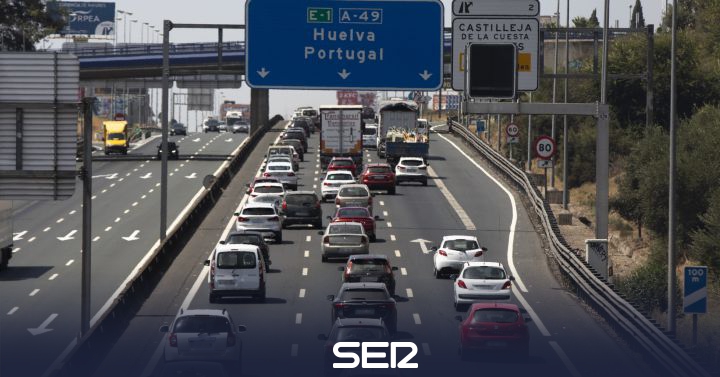The Spanish roads are enduring at noon this Saturday some retentions before the influx of drivers who return from the summer holidays and those who start them, with difficulties in Madrid, Murcia, Valencia, Seville, Malaga or Cantabria. According to the data from the General Directorate of Traffic bulletin, at around 12:30 p.m. two accidents complicated the circulation on the A-4 in Aranjuez (Madrid) in the exit direction and on the SE-30 in the Centennial Bridge in direction A -4.
Regarding the retentions due to the influx of cars, the A-1 registered traffic jams at the height of the Jarama Circuit heading out of Madrid. There was also slow traffic in Valencia on the AP-7 in Riba-roja de Tùria towards the A-3 and on this road at the entrance to Chiva. In the neighboring community, Murcia, the A-7 was the most affected, especially around Espinardo towards Alicante.
Meanwhile, in Cádiz it was the A-4 in Puerto Real towards San Fernando the one that supported the most traffic, and in Malaga the A-45 in Antequera in the direction of Lucena (Córdoba). In the north, in Cantabria there was dense traffic in Torrelavega on the link between A-67 and A-8. For its part, in Barcelona the AP-7 had slow traffic in La Roca del Vallès in both directions.
Almost five million trips
This weekend, the DGT foresees a record of car movements, with about 4,750,000, so it asks drivers “for an extra dose of prudence behind the wheel.”
This Friday night there was an accident in Barcelona and another accident occurred in Malaga on the A-7, over Fuengirola towards Almería, in addition to various retentions in Guipúzcoa, in Valencia, Murcia and Madrid, which is the first day of the ‘Operation Return’ of August.
Special device
With all this flow of vehicles on the road, the DGT has established a series of traffic regulation, management and surveillance measures, with the aim of facilitating the mobility and fluidity of the different road users and ensuring the safety of all of them . Among these, the following stand out: the installation of additional and reversible lanes with cones at times of greatest traffic flow and on the main access roads to large cities; and the restriction of the circulation of dangerous goods vehicles, special transport and trucks in general in certain sections, dates and times.
But also: the stoppage of road works and limitation to the holding of sports events and other events that involve the occupation of the road; and the design of recommended alternative itineraries according to origin and destination, with distances and travel times and, in some cases, avoiding the downtown area, which is the one with the highest traffic intensity.
To these measures are added the human resources available, among which are not only the agents of the Traffic Group of the Civil Guard (ATGC), but also the officials and specialized technical staff of the DGT that serves in its eight Traffic Management Centers and the more than 13,000 employees of the conservation and operation companies of the Ministry of Transport, Mobility and Urban Agenda and the rest of the road owners, as well as the personnel of the emergency services.
The special device also has all the material resources available to the DGT and among which are the 780 fixed radars (92 of them stretch) and 545 speed control mobiles, in addition to the 12 helicopters, 39 drones, 261 cameras and 15 camouflaged vans to monitor the use of mobile phones and seat belts.
recommendations
The DGT offers drivers a series of recommendations that allow them to make this return home in the best road safety conditions. Thus, it advises to plan the trip by the safest route to avoid unforeseen events; schedule the most appropriate time for the trip, avoiding the most unfavorable hours and, if necessary, use the proposed alternative itineraries; and avoid traveling at night or after a tired day on the beach or in the mountains.
Likewise, it recommends avoiding copious meals and moderate doses of stimulant drinks, as well as the consumption of those medications that reduce attention or cause drowsiness; and never drive under the influence of alcohol or drugs or let anyone who has done so get behind the wheel.
Finally, before embarking on the journey, he urges you to check the correct operation of the lights and turn signals, as well as the tire pressure; Remember that luggage must be correctly positioned, allowing the driver to have maximum visibility. Do not place objects on the rear tray of the vehicle that could cause damage in the event of sudden braking; and maintain attention in driving at all times and respect the traffic rules.
–

